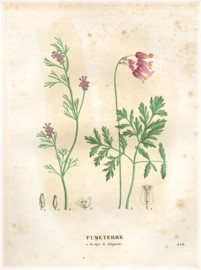Literal Bleeding Hearts
By Audrey Stallsmith

What helps it now, that Byron bore,
With haughty scorn which mock'd the smart,
Through Europe to the Aetolian shore
The pageant of his bleeding heart?
Matthew Arnold, "Stanzas from the Grand Chartreuse"
The term "bleeding heart" is most often used these days to refer to "a person who shows extravagant sympathy esp. for an object of alleged persecution." So it is often coupled with "liberal". But, just in time for Valentine's Day, this article will deal with the garden or "literal" bleeding heart!
The most impressive variety, Dicentra spectablis, originated in China and apparently didn't survive its initial debut in Europe. Fortunately, intrepid plant collector Robert Fortune reintroduced this foreign beauty in 1846.
Dicentra derives from the Greek dis ("twice") and kentron ("a spur"), in reference to the two hooks on each bloom. And spectabilis actually means "showy." The plant has also been known as heart of Jesus, heart of Mary, lady's eardrops, lady's locket, lady in a boat (or bath), and lyre flower.
With its three-feet-tall, graceful foliage and racemes of heart-shaped flowers, it makes a spectacular May show in my garden-frequently with sweet woodruff, forget-me-nots, or lilies of the valley blooming around its feet. But, like a philanthropist with a short attention span, this bleeding heart doesn't stick around. Once its flowers have withered, it promptly bows out, not to return until the following May.
Those looking for a longer-lasting dicentra might want to try the "fringed" variety, eximia. Although not as willowy, this type is still, as its name indicates, "out of the ordinary." A wildflower native to eastern America, it can continue to bloom on and off all summer. There is also a western type whose title, formosa, means "handsome."
The wilder branch of the dicentra family also includes Squirrel Corn (Dicentra canadensis), so named because its tubers resembled kernels, and Dutchman's Breeches (Dicentra cuccularia). Cuccularia, strangely enough, actually means "hood-like" rather than "pants-like!" Although Louise Beebe Wilder describes these two wildflowers as "pleasantly scented" in The Fragrant Path, she writes that the yellow-flowered Golden Ear-drop (Dicentra chrysantha) has "a strong narcotic odor."
Some of the wild dicentras have been used as tonics and/or diuretics, but they can be toxic. And their leaves sometimes raise a rash on sensitive skins. So you shouldn't "set your heart" on getting any medicinal benefit from this clan!
I have grown a climbing yellow-flowered dicentra whose flowers were neither profuse nor particularly impressive, but it did boast very pretty foliage. If I remember correctly, the plant also bled orange, like celandine. Unfortunately, it failed to survive our Zone 5 winter.
You can reportedly make a story out of a Dicentra spectabilis flower by dividing it into six pieces that are supposed to resemble 2 pink rabbits, a pair of earrings, a pair of Oriental slippers, and a dagger. The first five items supposedly stand for the gifts presented by an infatuated young man to a cold-hearted princess. And the last is what he stabbed himself with when she spurned him!
Not a cheery tale, granted. But, considering the shape of the blooms, it was almost inevitable that this plant come to represent romantic sorrow. The Chinese reportedly used it, like we use our daisy, as a seer of sorts!
But, instead of chanting, "he loves me; he loves me not," a hopeful maiden would simply crush one of the heart-shaped flowers. If it bled red, her love was returned. If it bled white, she might as well break out the lace hanky and consolatory chocolate.
Although it would have been relatively new at the time, bleeding heart was, reportedly, one of the plants most missed by American settlers after they made their westward trek. After all, few others perform so beautifully in shade.
And perhaps its blooms aptly symbolized the pioneers' initial homesickness. Also, despite its reputation as a heart-breaker, dicentra will faithfully return to you each spring-- just as long as you don't expect it to stick around for long!
Dicentra formosa image is from La Flore et la Pomme Francaises, courtesy of the Missouri Botanical Garden Library.








